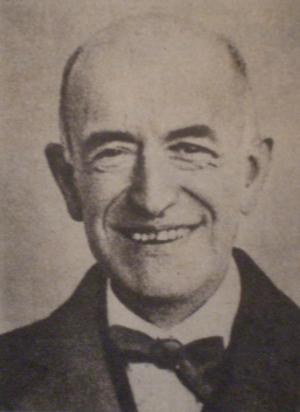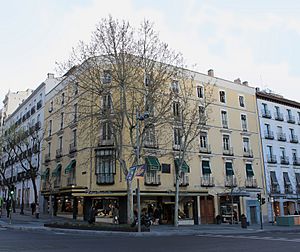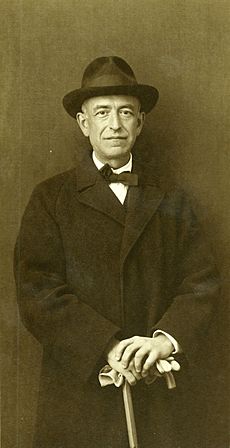Manuel de Falla facts for kids
Manuel de Falla y Matheu (born November 23, 1876 – died November 14, 1946) was a famous Spanish composer and pianist from Andalusia. He is considered one of Spain's most important musicians from the early 20th century, alongside Isaac Albéniz and Enrique Granados. Even though he didn't write a huge number of pieces, many people believe he was Spain's greatest composer of his time.
Contents
Manuel de Falla's Early Life
Manuel de Falla was born in Cádiz, Spain. His father, José María Falla, was from Valencia, and his mother, María Jesús Matheu, was from Catalonia.
When he was 13, in 1889, he continued his piano lessons with Alejandro Odero. He also learned about harmony and counterpoint from Enrique Broca. At 15, he became interested in writing and started his own magazines called El Burlón and El Cascabel.
Studying Music in Madrid
Around 1900, Falla moved to Madrid with his family. There, he studied piano at the Real Conservatorio de Música y Declamación with José Tragó. He also learned composition from Felipe Pedrell. In 1897, he wrote a piece called Melodía for cello and piano.
In 1899, he won first prize in a piano competition at his music school. He also performed some of his first works, including Romanza for cello and piano and Nocturno for piano. From this time on, he started using "de" in his name, becoming known as Manuel de Falla.
Because his family needed money, he began teaching piano lessons. During his time in Madrid, his teacher Pedrell helped him discover a love for the music of his home region, Andalusia. This included flamenco music, especially a style called cante jondo. This type of music greatly influenced many of his later works.
Falla also wrote some short Spanish musical plays called zarzuelas. In 1902, his zarzuela Los amores de la Inés was performed in Madrid. He also met another composer, Joaquín Turina, that same year.
His first important work was a short opera called La vida breve (meaning Life is Short). He wrote it in 1905. This opera won him first prize in a music competition. The prize included money and a promise that his opera would be performed in Madrid, though this didn't happen right away.
Seven Years in Paris
In 1907, Falla moved to Paris, France, and stayed there for seven years. In Paris, he met many famous composers who influenced his music, such as Maurice Ravel, Claude Debussy, and Igor Stravinsky.
In 1908, the King of Spain, Alfonso XIII, gave him money so he could stay in Paris and finish his Cuatro piezas españolas (Four Spanish Pieces). His opera La vida breve was finally performed in Nice, France, in 1913, and then in Paris in 1914. Critics loved it.
Just before World War I began in 1914, Falla finished his Siete canciones populares españolas (Seven Spanish Popular Songs). The war forced him to return to Madrid. This period marked the start of his most important and creative musical works.
Manuel de Falla's Famous Works
Back in Madrid, Manuel de Falla composed some of his most famous pieces:
- The nocturne (a night-themed piece) for piano and orchestra called Noches en los jardines de España (Nights in the Gardens of Spain) from 1916.
- The ballet El amor brujo (Love, the Magician) from 1915. This ballet includes the very famous Danza ritual del fuego (Ritual Fire Dance).
- Another ballet, The Magistrate and the Miller's Wife, which he later revised and renamed El sombrero de tres picos (The Three-Cornered Hat) in 1917. This ballet was produced by Sergei Diaghilev with costumes and sets designed by the famous artist Pablo Picasso. It was based on a Spanish novel.
Life in Granada
From 1921 to 1939, Manuel de Falla lived in Granada, Spain. There, he helped organize a special festival for cante jondo (a deep, traditional flamenco singing style) in 1922.
In Granada, he wrote a puppet opera called El retablo de maese Pedro (Master Peter's Puppet Show, 1923). He also wrote a concerto for harpsichord (an old keyboard instrument) and a small group of instruments (Harpsichord Concerto, 1926). These pieces showed a new style in his music, moving towards a more modern, neoclassical sound, similar to Igor Stravinsky's music.
Falla also started working on a large piece for orchestra and voices called Atlántida (Atlantis). This work was based on a Catalan poem.
Moving to Argentina
In 1939, after the Spanish Civil War ended, Manuel de Falla moved to Argentina. He continued working on Atlántida there, but it was not finished when he died. Another composer, Ernesto Halffter, completed it later.
In 1940, he was given a special honor, becoming a Knight of the Order of King Alfonso X of Castile. The Spanish government offered him a large pension to return to Spain, but he chose to stay in Argentina.
His health began to get worse, and he moved to a house in the mountains where his sister, María del Carmen, took care of him. Manuel de Falla died on November 14, 1946, in Alta Gracia, Argentina, from a heart attack. He had wished to be buried in Argentina, but his remains were brought back to Spain in 1947 and buried in the Cádiz Cathedral.
Manuel de Falla never married and did not have children.
Manuel de Falla's Compositions
Honours and Legacy
- In 1935, he became a member of the Royal Academy of Science, Letters and Fine Arts of Belgium.
- In 1940, he received the Grand Cross of the Civil Order of Alfonso X, the Wise.
- He was also a member of important Spanish academies, including the Real Academia de Bellas Artes de San Fernando.
Manuel de Falla's house in Granada is now a museum where people can learn about his life. His picture was even on the Spanish 100-pesetas banknote in 1970. A subway station in Madrid, on Line 10, is also named after him.
Recordings by Falla
- Manuel de Falla 1876–1946 Grabaciones históricas; Centro de Documentación Musical de Andalucía.
- Rollos de Pianola (Obras de Albéniz, Granados, Turina, Ocón, Chapí, Alonso y Otros) (Almaviva, DS - 0141) ASIN B000GI34D6
|
See also
 In Spanish: Manuel de Falla para niños
In Spanish: Manuel de Falla para niños







